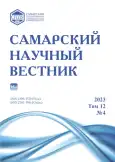Digital educational content compilation sources
- Authors: Sidorov A.A.1, Vasilieva D.I.2
-
Affiliations:
- Samara State University of Economics
- Samara State Technical University
- Issue: Vol 12, No 4 (2023)
- Pages: 247-251
- Section: Pedagogical Sciences
- URL: https://journals.rcsi.science/2309-4370/article/view/260667
- DOI: https://doi.org/10.55355/snv2023124312
- ID: 260667
Cite item
Full Text
Abstract
The development of digitalization of higher education leads to the emergence of new methods and means of learning. At present, information technologies are increasingly used, including distance learning, digital sources are used to create educational content, which opens new prospects for increasing motivation to study disciplines, activation of students’ activity in the learning process and, in general, for the professional success of university graduates. The article analyzes digital sources of spatial educational content compilation in mastering ecological and environmental educational disciplines and materials (by the example of bachelor’s training in the direction 21.03.02 Land management and cadastres). It is important for future specialists in the field of land management and cadastre to be able to use a variety of digital sources of data on the current state of land resources in their daily activities. The information sources in the form of spatial positioning public services, interactive topographic, geological and hydrological map, the map of dangerous exogenous geological processes manifestation, the map of territory functional zoning, the website of the Russian Federation hydrometeorological service management are shown and verified. It is important to use up-to-date geo-ecological and land-cadastral information when studying natural science disciplines, it is inadmissible to study outdated literary materials, inaccurate and unreliable data from electronic sources.
Keywords
Full Text
##article.viewOnOriginalSite##About the authors
Alexander A. Sidorov
Samara State University of Economics
Email: s.mich-81@yandex.ru
doctor of biological sciences, professor of Land Management and Ecology Department
Russian Federation, SamaraDaria I. Vasilieva
Samara State Technical University
Author for correspondence.
Email: vasilievadi@mail.ru
candidate of biological sciences, associate professor of Building Mechanics Engineering Geology, Grounds and Foundations Department
Russian Federation, SamaraReferences
- Алексеев В.Н., Клебанович Н.В. Востребованность электронного образовательного контента при изучении земельно-ресурсных дисциплин в вузах Беларуси // Перспективы развития высшей школы: мат-лы X междунар. науч.-метод. конф. Гродно, 2017. С. 215–218.
- Бражникова Н.С., Максименко Л.А. Применение технологий дополненной реальности в учебном процессе // Регулирование земельно-имущественных отношений в России: правовое и геопространственное обеспечение, оценка недвижимости, экология, технологические решения. 2022. № 1. С. 111–114.
- ГОСТ Р 53620-2009. Информационно-коммуникационные технологии в образовании. Электронные образовательные ресурсы. Общие положения [Электронный ресурс] // Гарант.ру. https://base.garant.ru/70227430.
- Павленко Т.С. Понятие «контент»: типология, виды и технология получения дидактического контента в образовательном процессе // Известия Волгоградского государственного педагогического университета. 2017. № 10 (123). С. 31–35.
- Молокина Т.С., Колесников А.А. Анализ состояния и перспективы развития визуализации пространственных данных // Вестник СГУГиТ (Сибирского государственного университета геосистем и технологий). 2021. Т. 26, № 4. С. 73–82.
- Сидоров А.А., Савинкова К.И. Применение прикладных программ геоинформационных систем в кадастровых работах на земельных участках // Российская наука: актуальные исследования и разработки: сб. науч. ст. XIII всерос. науч.-практ. конф.: в 2 ч. Ч. 1. Самара: Изд-во СГЭУ, 2022. С. 54–59.
- Парк культуры и отдыха им. Ю.А. Гагарина на территории г.о. Самара [Электронный ресурс] // Интерактивная топографическая карта. https://ru-ru.topographic-map.com.
- Геологическая карта Самарской области [Электронный ресурс] // Санкт-Петербургское отделение института геоэкологии им. Е.М. Сергеева. https://hgepro.ru/mapgis/subekt/samara/11_geol_sam.pdf.
- Государственная геологическая карта Российской Федерации [Электронный ресурс] // Геологическая библиотека. https://www.geokniga.org/sites/geokniga/files/maps/n-3839-samara-gosudarstvennaya-geologicheskaya-karta-rossiyskoy-federacii-kart_1.jpg.
- Интерактивная карта ГМСН [Электронный ресурс] // https://gmsnmap.geomonitoring.ru
- Карта проявления опасных экзогенных геологических процессов на территории Российской Федерации [Электронный ресурс] // Сибирский региональный центр ГМСН. https://eis.specgeo.ru/?f=maps_egp_pp.
- Муниципальный геопортал Самары [Электронный ресурс] // https://map.samadm.ru
- Экологический бюллетень по Самарской области за 2022 год [Электронный ресурс] // ФГБУ «Приволжское УГМС». https://pogoda-sv.ru/pollcenter/annual_review/42.
Supplementary files













